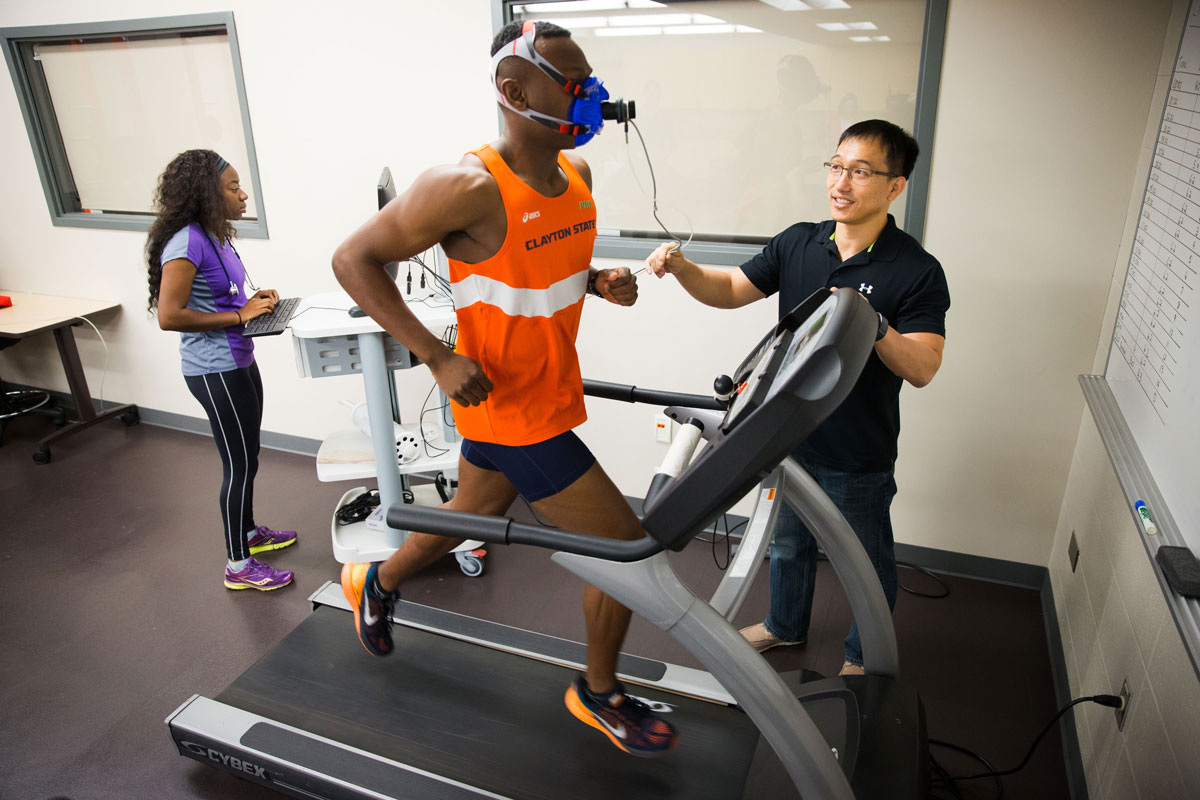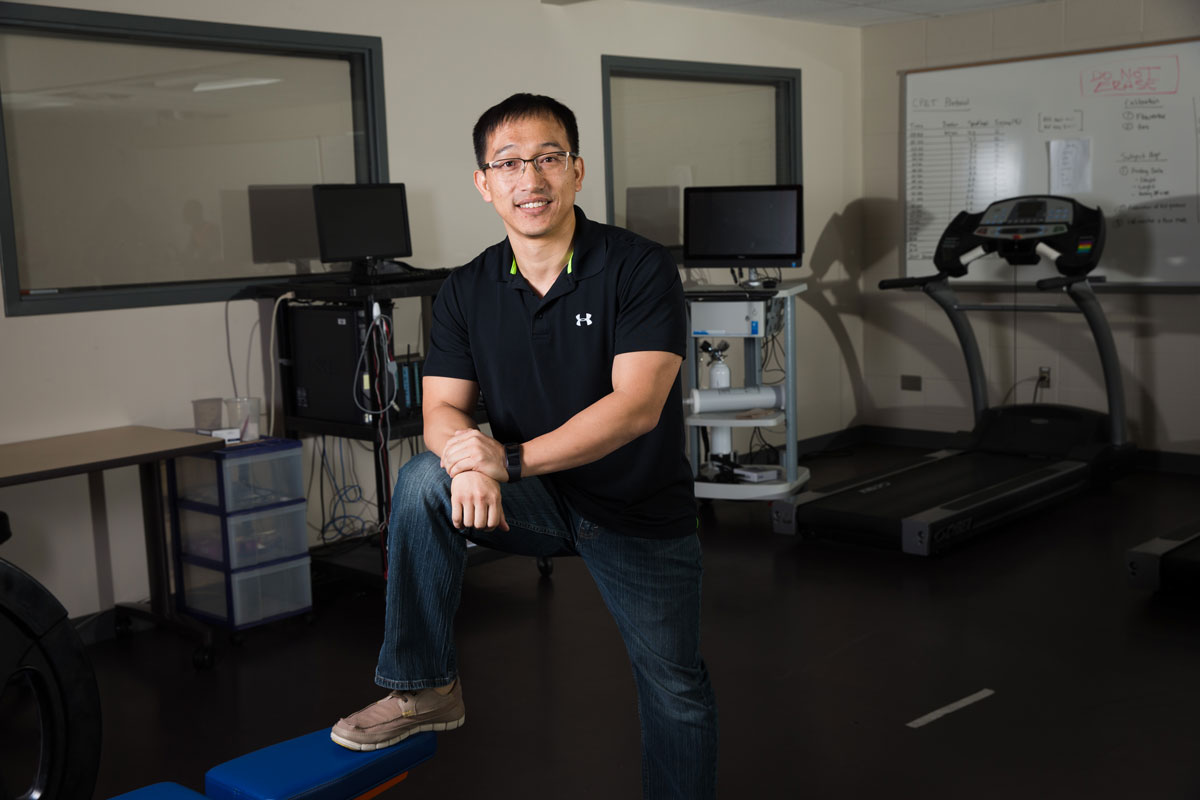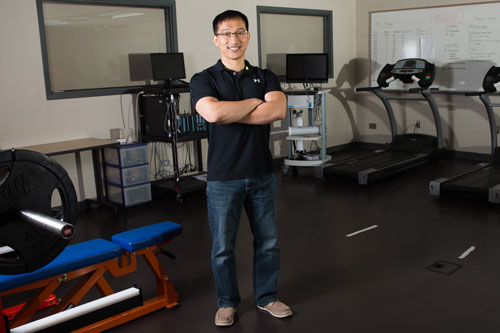
Share the Story on FacebookShare the Story on TwitterShare the Story via EmailShare the Story on LinkedIn
|
Just Breathe
A new metabolic cart is helping students and researchers see how a person’s fitness level measures up
It’s common knowledge that when you move you consume oxygen. And when you move fast, your heart rate and blood pressure rises.
But what if those factors can be measured to help a person lose weight, improve the cardiovascular system of a post-operative heart patient or push a world-class athlete to reach their peak performance?
That’s where a metabolic cart becomes useful.
A metabolic cart is a device that measures the maximum oxygen output of an individual while engaged in intense exercise. Users are outfitted with an oxygen mask and step onto a treadmill that is attached to a computer to capture data.
As the incline and speed is increased on the treadmill, the computer records oxygen and carbon dioxide levels, heart rate and blood pressure. Test subjects are pushed to their limit to measure their maximum oxygen consumption, known as VO2max, to determine their cardio-respiratory fitness.
“If you have a high VO2max number, it means the less chance of cardiovascular disease; it is a good indicator,” says Dr. Harry Chung, assistant professor of Health and Fitness Management at Clayton State University. “And based on that VO2max, you can make exercise programs.”
The Health and Fitness Management (HFM) department in the College of Arts and Sciences acquired a metabolic cart in early 2015 and started using it in class this year. Students test the machine and conduct classroom research as part of their coursework. The cart is also supplemented with an electromyograph (EMG) to evaluate electrical activity produced by the skeletal system and an electrocardiograph (ECG) to evaluate heart rhythm.

Chung says the metabolic cart is especially helpful for college athletics programs to assist strength and conditioning coaches with developing scientific-based fitness programs instead of making educated guesses on student-athlete training and performance.
“Say, for instance, we have a new coach who has a new athletic program and wants to prove if it works. We can measure an athlete’s VO2max before the program, then wait 8 weeks for them to test the program and then come back and measure again to see if the VO2max improves,” Chung says.
An increased VO2max means the program is working, Chung added, while no improvement let’s a coach know the program is no good.
“So you can’t just say this program is awesome and it works for me,” Chung added. “It works for you, but not for your students.”
Student-athletes from various sports at Clayton State have used the metabolic cart.
“My coach bases his workouts on heart rate, so this correlates directly with what we’ve done with our training,” says T.J. Witherspoon, an HFM student who runs track and cross country.
Nouri Moore, a former student-athlete studying Health and Fitness Management, says the metabolic cart can help athletes gauge their own speed.
“Your coach can tell you anything, but everyone is different when you run,” she says. “Knowing your full maximal speed that you can use and how to use it when you’re running, helps you not burn out faster, you can run longer and your muscles will be healthier.”

“A lot of organizations and doctors advise you to exercise if you have heart problems,” Chung says. “If you want to see your heart and lung function—cardiopulmonary—this machine can test that.”
Chung says outside of fitness and athletics, the students he trains can become certified exercise specialists that can work in hospitals. The metabolic cart can collect data for 20 to 30 different measures in addition to VO2max.
Hospitals conduct stress tests on patients, for example and can test heart function for a patient during therapy after a surgical operation. The metabolic cart, Chung says, makes it a valuable piece of equipment that can be used for a variety of conditions on all kinds of people.
“A lot of organizations and doctors advise you to exercise if you have heart problems,” he says. “If you want to see your heart and lung function—cardiopulmonary—this machine can test that.”
Chung is conducting his own research using the metabolic cart to examine oxygen consumption and muscle activity in the general population to measure how much energy is expended for muscle and oxygen.
“Numerous studies have reported that the self-selected locomotive pace in humans is that at which the most efficient energy cost can be maintained,” Chung explains. “Above or below this naturally selected gait length at a particular speed, the energy cost increases, resulting in a U-shape energy cost curve.”
Chung’s hopes to determine whether training individuals to increase their optimal walking speed and change their stride length can affect energy efficiency, heart rate and muscle activity. The study could offer insight into developing better training programs to improve walking.
Read more stories from this issue
About Dr. Hae Ryong “Harry” Chung
Hae Ryong Chung is an Assistant Professor in the Health and Fitness management program. He holds a PhD in Exercise Physiology from the University of Illinois at Urbana-Champaign. Before He came to the U.S., Chung completed a master’s degree in exercise physiology at Kookmin University and a bachelor’s degree in chemistry at Chungnam National University in his native South Korea.

His PhD research has included two distinct areas: clinical research with dialysis patients and laboratory work with animal models. He has a wide range of experience in the health and fitness industry, ranging from personal or group training and gym management to clinical exercise prescription.
